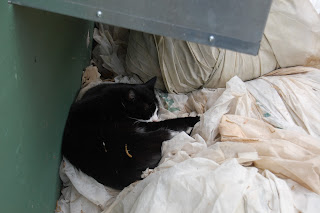During farm season 2010 David had a very successful winter squash harvest. For farm season 2011 David, based on how well things had gone in 2010, planted nearly twice as much winter squash. Sadly, primarily due to weather conditions (too much heat, too much rain), the resulting crop was about half as much. Though David eliminated a couple of varieties from last year, and cut back on the number of plants of a couple of other varieties, this seasons planting was again significant. Despite some hurdles presented by the weather, and though some varieties did not do as well as others, the overall harvest was quite bountiful.
People at market responded very favorably to the winter squash that was brought to market. David started bringing winter squash to markets the end of September. By the last market, on December 1, David had sold out of spaghetti squash, delicata, sugar dumpling, acorn, and honey nut. All that remained was a small amount of kabocha, about a crate of butternuts, and a smattering of varieties that are not as familiar to people as the others. Below you will see pictures of the different varieties of winter squash that David grew with a brief description of what is picture. The pictures and descriptions will be broken into two posts. Stay tuned for part 2.
In this picture there are delicata in the front left corner of the basket (the slender ones with the green veins), spaghetti squash (the back row) and butternuts (front right corner).
Delicata- very creamy flesh. Light and bright tasting. Flavor hints of summer squash.
Spaghetti- Can be baked, boiled, or micro waved. When cooked use a fork to 'scrape' at the flesh which will form spaghetti like strands. Use instead of spaghetti.
Butternut- Smooth, rich, dense flesh with a distinctively nutty flavor.
The display at the Rittenhouse Square Market. Notice the crate of watermelons on the right side of the picture. Melons were planted late and overlapped with the winter squash.
Another picture at Rittenhouse. Please note the tomatoes on the left side of the picture. The tomatoes were part of the second planting of tomatoes. Also, notice the basil. At this market, in addition to other goodies, winter squash, tomatoes, and watermelon shared the stage. The orange pumpkins in the center of the picture, the ones that look like small Jack-O-Lantern pumpkins, are pie pumpkins. The flesh of Jack-O-Lanterns is usually watery and bland and do not make for good eating. The flesh of pie pumpkins is usually dense and is sweet to taste.
Pictured here are Long Island Cheese Pumpkins. Believed to be one of the oldest domesticated squash varieties selected
for food, this squash dates back to the early 1800's. Was especially famous in the 1800s through the
first half of the 20th century for making pumpkin pies. Named because it
resembles a flattened cheese wheel, it looks similar to a pale pumpkin.
Its flesh is smooth and sweet, and lacks the stringiness found in many
squashes, making it excellent for baking.
The big gourd like 'pods' in the center of the picture are Blue Hubbards. The long, narrow squash on the right side of the picture are Guatemalan Blue.
Blue Hubbards- sweet, fine-grained, golden flesh. Great for baking, pies, and soup. The hard, blue-gray shell helps these keep for long periods in storage. Dates back to the late 1700's.
Guatemalan Blue Banana- When grilled or baked, the golden flesh becomes rich and creamy.
Galeux d'Eysiunes- The sweet orange flesh is used for soups and also can be baked. This heirloom's French name translates as "embroidered with warts from Eysines," that being a small town in southwest France. This heirloom pumpkin's random "peanut" warts bedeck the flesh-colored outer skin. A unique decorative piece, but also a richly flavored eating pumpkin.
-->
Musquee de Provence- Another variety from France. Big flat fruits are reminiscent of big wheels of cheese. Green when immature and ripen to a deep, rich brown when fully ripe. Deep orange flesh, very fine flavored. Great for baking. Introduce to American gardeners in 1899.
Kikuza- A Japanese variety introduce to American in 1927. Very thick-fleshed with excellent eating qualities. Perfect size for baking and roasting. This Japanese heirloom, introduce to America in 1927, has orange flesh that is sweet and dry and has a spicy flavor.
One last note- Winter squash are generally harvested all at once, sometime during the early fall. They will finish their ripening off the vine prior to being brought to market. David first brought his squash to market at the end of September and still had, as mentioned above, some butternut and kabocha squash, with a smattering of other varieties, left at the beginning of December. These remaining squash are still in great shape and will stay that way for weeks, if not months, to come. As a general rule, winter squash can be stored, out of direct sun/heat, out of freezing temperatures, for months. The length of storage will be determined by the specific squash that you have. As long as the squash are not bruised, they will be ready to be cooked whenever you get around to using them.
Happy and healthy eating to one and all. Support your local farmer.























































